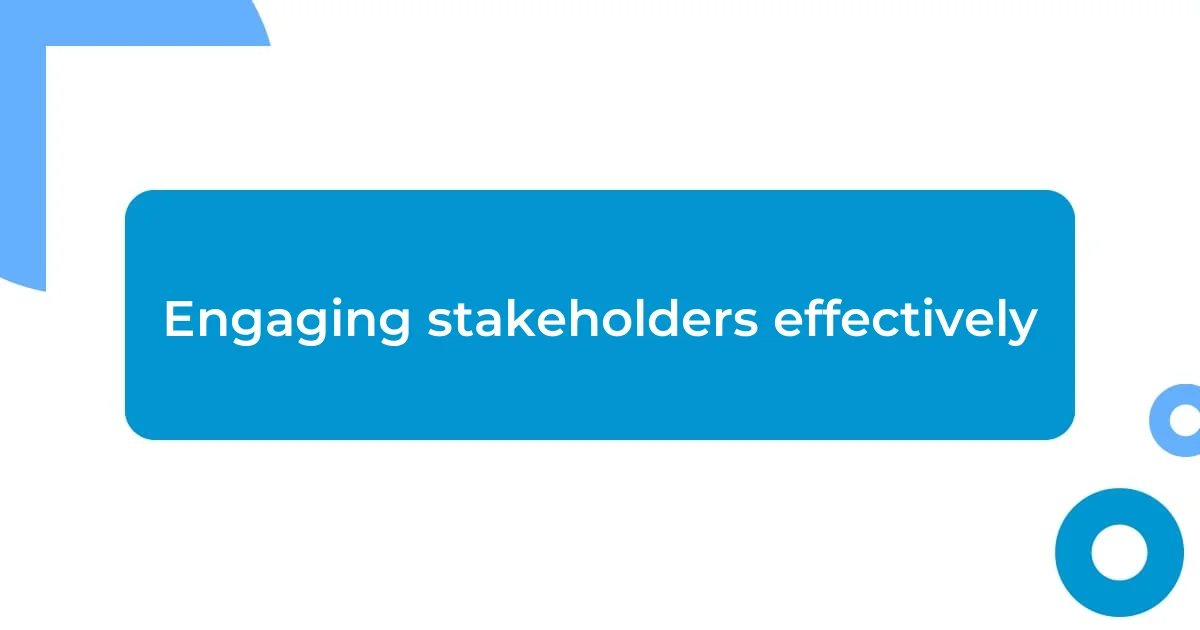Key takeaways:
- Diversifying funding sources is crucial for non-profit financial sustainability, balancing small grants, earned income, and community fundraising to reduce dependency on a few donors.
- Effective budgeting and strategic planning aligned with organizational goals enhance clarity and discipline, transforming financial challenges into opportunities for growth.
- Engaging stakeholders through clear communication and relationship-building fosters trust and strengthens community ties, essential for long-term support and collaboration.

Understanding financial sustainability
Financial sustainability is all about maintaining steady funding and resources over the long haul. I remember the early days of my nonprofit when every donation felt like a lifeline. It’s nerve-wracking to constantly seek funding, and it really hit home when I realized how reliant we were on just a few donors. Have you ever felt that weight of uncertainty looming over your organization?
As I delved deeper into understanding financial sustainability, I began to see it as a blend of predictable income and effective resource management. I found that diversifying our funding sources made a significant difference. Small grants, earned income, and community fundraising all contributed to a more stable foundation. It was like piecing together a puzzle—it took time, but the picture started to emerge clearly, and I could breathe a little easier.
Moreover, financial sustainability requires a proactive approach to budgeting and strategic planning. I recall our first budget meeting where we prioritized not only what we wanted to achieve but also how we could align our financial goals with our mission. It felt empowering to have a plan that directly supported our vision, raising the question: how can you ensure that your financial choices echo your mission? That alignment is crucial—it transforms financial challenges into opportunities for growth.

Identifying funding sources
Identifying funding sources can feel like combing through a treasure chest where some gems shine brighter than others. I remember my initial struggle to pinpoint the right avenues for my nonprofit’s financial support. It was a journey of trial and error, pushing me to think outside the box. For instance, while chasing large corporate sponsorships can be tempting, I found that smaller, community-based sources often provided a more reliable and consistent flow of funds.
As I explored various funding avenues, I began to appreciate the importance of being adaptable. I experimented with different approaches, from organizing local fundraising events to applying for grants that aligned with our mission. Each funding source seemed to tell its own story—some were pursued with passion and enthusiasm, while others required a more strategic mindset. I realized that understanding the unique context of each source often made the difference between success and disappointment.
Merging traditional methods with innovative ideas became essential in broadening my funding horizons. Connecting with local businesses for mutually beneficial partnerships opened doors I hadn’t previously considered. I found it enriching to engage with my community in this way, forging connections that not only brought in funds but also elevated our organization’s profile. Looking back, the diverse funding sources I identified not only stabilized our cash flow but also deepened our community ties.
| Funding Source | Characteristics |
|---|---|
| Grants | Often competitive, requiring detailed proposals and aligned missions. |
| Corporate Sponsorships | May offer substantial funds but can come with expectations for marketing and visibility. |
| Individual Donations | Usually more consistent and personal, but may require ongoing relationship building. |
| Fundraising Events | Engaging and community-focused, but demand significant planning and resources. |
| Earned Income | Revenue generated through services or products, offering sustainability but requiring a strong business model. |

Building a robust budget
Building a robust budget is essential to ensure that a nonprofit can navigate both the expected and unexpected challenges of running an organization. I vividly remember sitting down with my team for our annual budget planning session, feeling a mix of excitement and anxiety. We poured over last year’s figures, dissecting every dollar spent and comparing it against our mission goals. This careful examination revealed areas where we overspent, and it also illuminated opportunities for investment that could enhance our impact. It was an eye-opening experience that made me realize how pivotal budgetary discipline would be for our journey.
To create a practical budget, consider these key steps that helped shaped my approach:
- Evaluate Past Expenses: Look back at your financial history. Understanding where your money went can guide future decisions.
- Set Clear Goals: Determine what you want to achieve for the coming year. Aligning financial goals with organizational objectives is crucial.
- Prioritize Investments: Identify areas that require funding to further your mission, focusing on initiatives that have the potential for significant return or impact.
- Incorporate Flexibility: Life is unpredictable. Ensure your budget allows for adjustments and unexpected expenses, as I learned during one particularly challenging fiscal quarter.
- Monitor Progress: Regularly review your budget against actual income and expenses to stay on track, making necessary adjustments as you go along.
Establishing this budgeting discipline can feel overwhelming at first, but the clarity it provides is worth every bit of effort. I often remind myself that our budget is not just a number—it’s a reflection of our priorities and aspirations. For me, adopting a robust budgeting strategy transformed not only our financial processes but also strengthened my team’s collective resolve to make a meaningful impact.

Developing a diversified income stream
Developing a diversified income stream has been a pivotal step in my journey toward financial sustainability. I can recall a moment when I realized dependence on a single funding source was like walking a tightrope—one misstep and everything could come crashing down. That realization pushed me to explore different avenues, such as hosting workshops or selling branded merchandise. Each new approach taught me invaluable lessons about resilience and adaptability.
One of my most rewarding experiences came from collaborating with local artists for a series of community art events. Not only did it generate revenue, but it also strengthened our bonds within the community. I found myself asking, “What else can we create together?” This curiosity opened doors to partnerships that transformed our funding landscape—from corporate sponsorships to individual donations, each income source complemented the others, creating a safety net I hadn’t anticipated.
I also learned that incorporating earned income streams could significantly enhance our financial stability. Creating programs that aligned with our mission while generating revenue taught me the importance of business acumen in nonprofits. I often reflect on how joyfully our team embraced the challenge, rallying around ideas that not only funded our initiatives but also fueled our passion. It’s this blend of creativity and commitment that ultimately laid the groundwork for a robust and diversified income stream.

Engaging stakeholders effectively
Engaging stakeholders effectively has proven to be a cornerstone of my nonprofit’s journey. I vividly recall a town hall meeting where we invited community members to share their ideas. The energy in the room was palpable; every voice contributed a unique perspective, and it struck me how vital it is to create a space where stakeholders feel valued. Listening to their insights not only fostered trust but also illuminated paths we hadn’t considered before.
I learned early on that communication is key. After one particular outreach campaign, I was disheartened to find only a handful of responses. It sent me back to the drawing board. I realized we hadn’t clearly articulated our mission or how stakeholders could directly impact our cause. By refining my messaging and sharing authentic stories about our work, I witnessed a remarkable shift in engagement. I often wonder—what would have happened if I’d never tackled that communication barrier?
Building relationships is another essential element in engaging stakeholders. There was a moment when one of our longest-standing contributors felt overlooked during our planning sessions. I scheduled a catch-up over coffee, and the conversation revealed underlying concerns that had been brewing for months. By acknowledging their feelings and involving them in future initiatives, we strengthened not just our bond but also their commitment to our cause. It’s amazing how a simple gesture, like a heartfelt conversation, can turn a fragile connection into a powerful alliance.

Measuring and evaluating financial health
One of the most tangible ways I’ve measured our nonprofit’s financial health is by analyzing our balance sheet regularly. I remember the first time I sat down with our finance officer to dissect the numbers; it felt like peeling back layers of an onion. We looked closely at assets, liabilities, and net assets, and I was struck by how understanding these figures not only provided clarity but also pointed to areas where we could improve. I often ask myself, “How can we turn these insights into actionable strategies?” It’s a constant cycle of evaluation, ensuring that every financial decision aligns with our mission.
Cash flow is another vital indicator I closely monitor. In the early days, I underestimated its importance, thinking that as long as donations were coming in, we were in good shape. But there was a wake-up call when a large funding source temporarily paused its contributions, leaving us scrambling. Since then, I’ve learned to maintain a cash reserve that allows us to weather those inevitable ups and downs. How often do we consider what’s happening behind the numbers? I now understand that seeing the cash flow forecast as a story of our organization’s vitality helps me plan for growth instead of merely reacting to setbacks.
Finally, I’ve adopted the practice of benchmarking against similar organizations. I recall a conference where I met representatives from other nonprofits in our sector. Sharing our financial metrics turned on a light bulb for me; I realized that comparing our operational ratios and fundraising efficiency against peers provides insights that raw numbers alone could not. I often wonder what lessons lie hidden in the data of others. By engaging in these comparisons, I’ve gained valuable perspectives that not only bolster our accountability but also spark new ideas for improving our financial health.

Adapting to financial challenges
Embracing financial challenges has been a pivotal part of my journey. I recall a particularly tough month when donations dipped unexpectedly, leaving us scrambling. It felt like I was standing at the edge of a cliff, unsure of how to proceed. In that moment, I realized I had to pivot quickly, brainstorming alternative fundraising ideas and engaging with local businesses. I often found myself wondering—how could we turn this adversity into an opportunity for growth?
Adaptability became my mantra. I implemented a strategy to diversify our funding sources, recognizing that relying solely on one or two channels could spell disaster. When I sought local sponsors for events, I felt a mix of excitement and fear. What if they said no? Yet, to my surprise, many were eager to collaborate, and their support helped stabilize our income. This experience taught me that stepping out of my comfort zone not only yields results but also opens doors to new partnerships. Have you ever discovered strength in facing your fears?
One of the most significant adjustments I made was enhancing our digital presence. During the pandemic, traditional methods of outreach fell flat. I jumped into webinars and social media campaigns, experimenting with new formats. There were moments of failure—like that first live stream where only a handful of viewers tuned in—but I kept at it. Each stumble became a lesson, fueling my determination to connect with our audience in innovative ways. I sometimes wonder how many nonprofits miss out on potential growth by sticking to the old ways. By adapting to the shift, I found not only renewed engagement but also a robust way to communicate our mission in a rapidly changing world.














